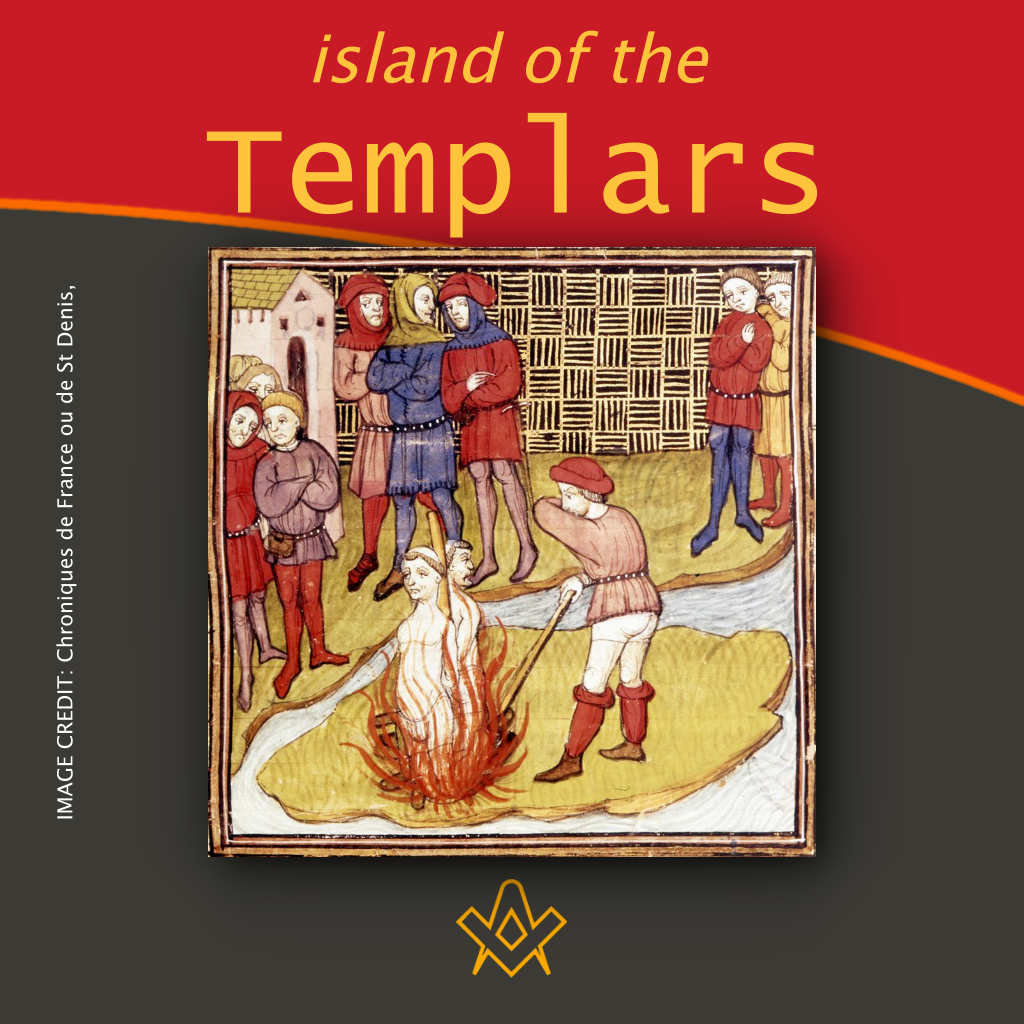On a hot summer’s day after exiting the famous bookshop, Shakespeare and Company, I am greeted by the sight of Notre Dame cathedral. Contrary to the gothic sense of gloom so often portrayed, the Notre Dame stands valiant and bright in the Parisian sunshine.
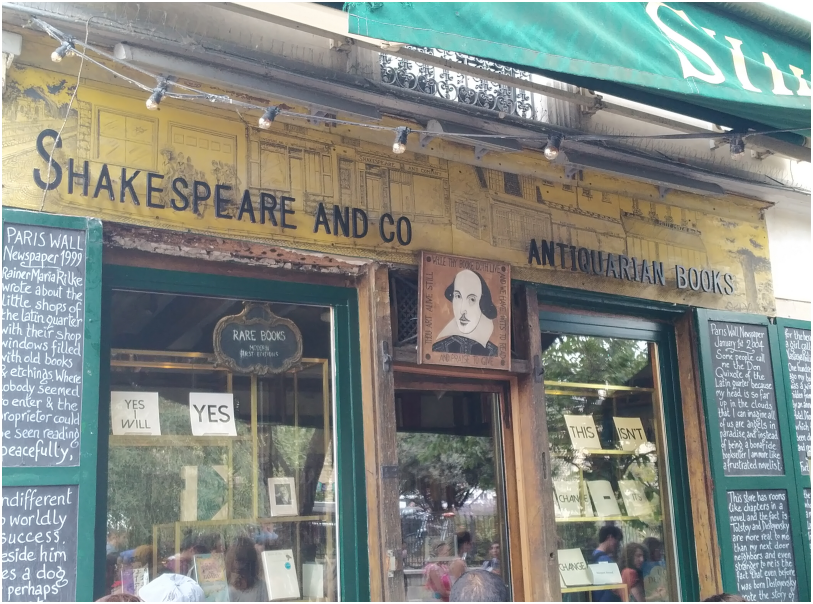
Shakespeare and Co. Bookshop, Paris
IMAGE CREDIT: Devika Lishanin
I find it easy to get lost in the chaos; weaving amongst the crowds of tourists eager to explore a cultural metropole.
On the plaza of the cathedral is a bronze equestrian statue of Charlemagne, King of the Franks, now a deep turquoise due to oxidisation over time, having been completed in 1878.
After absorbing more of the typical tourist sites, I cross the road and continue through the busy pavements of Paris, eventually winding up at the Pont Neuf, the oldest standing bridge across the Seine.
I make my way down a set of stairs which are situated next to another oxidised equestrian style statue – this time King Henry IV of France.
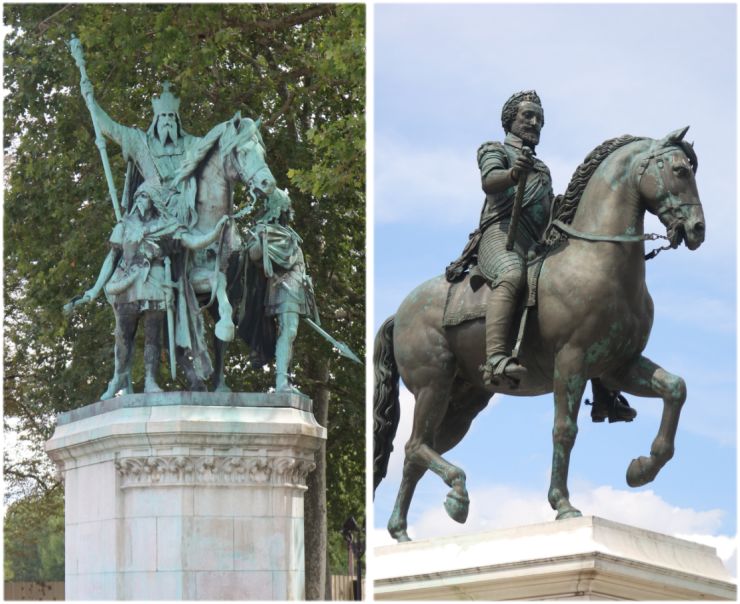
Left: Statue of Charlemagne, King of the Franks – Paris.
Right: Statue of King Henry IV of France, Pont Neuf, Paris
IMAGE CREDIT: Devika Lishanin
The bottom of the staircase leads to the entrance of a small park, the Square du Vert Galant.
Historically, Île aux Juifs, literally translating to “Island of the Jews” due to the numerous executions of Jewish people which took place during the Middle Ages, used to be part of the Square.
An alternate name, Île des Templiers, or “Island of the Templars” pertains to its position as the execution site of Jacques du Molay, the last Grand Master of the Knights Templar.
By the staircase lays a plaque dedicated to this very event:
‘A cet endroit / Jacques de Molay / Dernier grand maître / de l’ordre du temple / a été brûlé le 18 Mars 1314’
(‘In this location / Jacques de Molay / Last grand master / of the order of the temple / was burned on 18 March 1314’).
Across, at the entrance of the park is another commemoration plaque establishing the little park as a part of the “Histoire des Paris”.
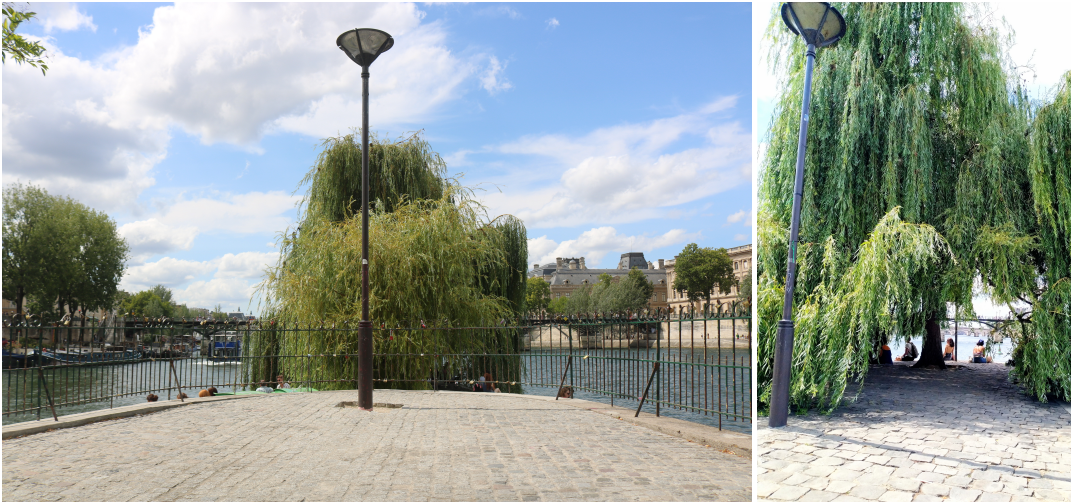
Île des Templiers – Isle of the Templars – Square du Vert Galant, Paris.
IMAGE CREDIT: Devika Lishanin
The park is near enough full of occupants, but still manages to maintain a languid and leisurely air, providing for a gentle stroll with close view of the Seine – close enough to dangle your feet over.
In the heat of a Parisian summer, it is almost surreal to imagine this secluded, picturesque park as the site of such brutal political executions, which stemmed from the loss of the Holy Land in the aftermath of the Crusades, for which the Templars were blamed.
Because of this, the once celebrated Order garnered a sense of wariness and distrust from the monarchies of Europe, only maintaining Cyprus as their main stronghold in the East.
The relationship between the Templars and the French monarchy, as well as the Catholic Church, was further antagonised by Molay’s opposition to Pope Clement V’s proposal of forming a coalition between the military orders in the event of a new crusade.
Molay’s assertion of his belief in the strength of the separation of the various military orders, completely countered the interests of Pope Clement V and those of France’s King Philip IV, who was already in abysmal debt to the Templars.
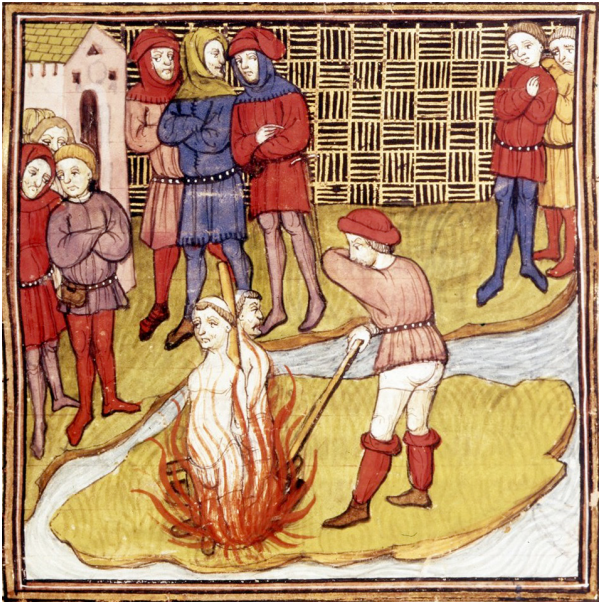
Detail of a miniature of the burning of the Grand Master of the Templars and another Templar. From the Chroniques de France ou de St Denis, BL Royal MS 20 C vii f. 48r/h
IMAGE LINKED: wikimedia Attribution 4.0 International (CC BY 4.0)
On 13 of October 1307, the arrests and interrogations of the Templars began under the command of Philip IV, with their trials continuing for the next seven years, eventually culminating in the 1314 execution of Molay.
The initial charges included renunciation and spitting on the cross upon initiation into the Order, along with several other concocted allegations of blasphemy, idol worship, obscenity and heresy.
Eventually the charges would be greatly increased, spearheaded by the King’s intent to demolish the order, and upon doing so, seize their wealth, with the religious nature of the charges also helping to maintain the King’s façade as a servant of God, further cementing the concept of his Divine Right to rule.
By 24 of October, most likely under torture of the King’s inquisitors, Molay confessed to the crimes during his interrogation.
He apparently admitted that the initiation into the order included the denial of Christ and “trampling on the cross.”
Molay was additionally made to write letters to all the Templars, asking them to admit to the charges, thus giving justification for King Philip to escalate pressure on the Pope, who would call for the arrest of all the Templars within the Christendom.
In December, the Pope, willing to take into consideration Molay’s version of events, sent two cardinals to Paris, where Molay would take back his earlier confessions, instead claiming they had been exacted by torture.
However, the damage had already been done. Another questioning, this time in the presence of royal agents, resulted in Molay turning back to his admissions of heresy made under force.
Although he again disavowed his previous admissions two years later by refusing to acknowledge the allegations against his order, King Philip already had enough in the form of the previous confession to sentence fifty-four Templars to their deaths at the stake in May 1310.
Interestingly though, it was not King Philip who gave the final order for Molay’s grisly demise.
Molay, along with fellow Templar Geoffroi de Charney, was sentenced to death under the jurisdiction of the cardinals in France representing the Pope.
On 18 March 1314, Jacques de Molay and fellow Templar leaders Geoffroi de Charney, Hugues de Peraud, and Godefroi de Gonneville were released from their seven-year captivity and brought to a scaffold on Île aux Juifs in the river Seine, which was located across from the King’s palace, making a more convenient viewing for him.
Molay also requested to be facing the Notre Dame Cathedral so that he could die in prayer.
However, before their deaths, Molay and Charney proclaimed their innocence once again – the only crime they were guilty of was the betrayal of their own Order to save themselves.
In contrast to the typical arrangements of the time in which those sentenced to the pyre would die from asphyxiation, Molay’s pyre was prepared in the inquisitorial method so that he would slowly burn alive from the feet upwards to prolong his suffering.
Despite this degree of cruelty inflicted upon him, eyewitnesses to the execution said that Molay showed no fear in the moments leading up to his death, with French chronicler Guillame de Nangis recounting that;
“They [the Templars] were seen to be so prepared to sustain the fire with easy mind and will, that they brought from all those who saw them much admiration and surprise for the constancy of their death and final denial…”
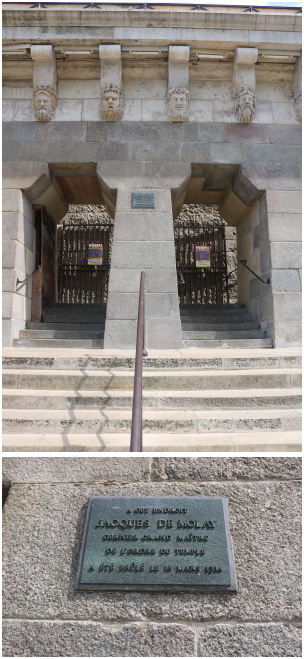
The execution site of Jacques du Molay, the last Grand Master of the Knights’ Templar bears a plaque with the epitaph ‘A cet endroit / Jacques de Molay / Dernier grand maître / de l’ordre du temple / a été brûlé le 18 Mars 1314’ (‘In this location / Jacques de Molay / Last Grand Master / of the Order of the Temple / was burned on 18 March 1314’). Photos: Devika Lishanin
IMAGE CREDIT: Devika Lishanin
The martyrdom of Molay, which for some drew parallels to the crucifixion of Christ, gave way to legend of a curse.
Upon proclaiming his innocence at his execution, legend says that he cursed the Pope, King Philip IV, and all his descendants.
Geoffroi de Paris, a chronicler who served as a clerk in King Philip’s court recounted the last words of Molay in verse as:
“God knows who is in the wrong and has sinned. Misfortune will soon befall those who have wrongly condemned us; God will avenge our deaths. Make no mistake, all who are against us will suffer because of us…”
On 29 of November 1314, King Philip IV would die of a stroke whilst out hunting in the Forest of Halette, and within fourteen years, all of his sons and grandsons would also die, bringing an end to the dynastic House of Capet which had reigned over France for three hundred years.
Pope Clement would succumb to illness and die in April of 1314. In “A History of The Inquisition of The Middle Ages, Volume 3”, American publisher and historian Henry Charles Lea states that;
“…Philippe’s death was spoken of as a retribution for his destruction of the Templars, and Clement was described as shedding tears of remorse on his deathbed for three great crimes, the poisoning of Henry VII, Holy Roman Emperor, and the ruin of the Templars and Beguines.”
To further galvanise the air of mystique surrounding Molay’s curse, rumours arose that the church where the Pope’s body lay in state was set alight after being struck by lightning from a storm.
However, a discovery over five centuries after Molay’s death would cast a new light on the circumstances of his demise, and call into question whether his brutal execution could have been prevented after all.
In 2001, palaeographer Barbara Frale discovered a document entitled The Chinon Parchment in the Vatican Secret Archives, which confirmed Pope Clement V’s absolution of Molay and the other Order leaders in August of 1308 after their extended interrogation by his trusted cardinals.
Upon hearing the Templar’s defence against the accusations, for example spitting on the cross, which was justified by the argument that it prepared them in the event of capture by a Muslim enemy during the Crusades, would capture the Pope’s sympathies and result in their absolution. It stated that:
“we decided to extend the absolution of these acts to brother James of Molay, the Grand Master of the said order, who in the form and manner described above had denounced in our presence the described and other heresy, and sowre in person on the Lord’s Holy Gospel, and humbly asked for the mercy of absolution, restoring him to unity with the Church and reinstating him to communion of the faithful and sacraments of the Church.”
This absolution, which had the potential to save Molay and the other Templars from their fate was never released to the public, instead being hidden away and documented in 1628 under a vague description.
The dissolution of a centuries’ old Order and its leader came to a conclusion on this meagre island.
For some, it is a place to delve into a shrouded Parisian past floating on the banks of the Seine.
For others it is a place to lay on a patch of grass, watching the bustling streets of Paris hurry by underneath the watchful eye of the summer sun.
Molay’s shouted proclamation of innocence and his curse has settled into the murmurs of lovers sharing a cigarette, the chatter of schoolchildren unable to stand still.
The Parisians who rushed to rummage through the ashes of the Templar leaders, now rush with the same sense of vigour through the restless streets of the metropole, in search of their own holy relics for the day.
Devika Lishanin is a student of English Literature, Modern History, and Fine Art. Her love of travel, history and culture is encapsulated in her travelogue writings.

The Templars: The Secret History Revealed
By: Barbara Frale
With a Foreword by bestselling author Umberto Eco, The Templars chronicles the rise and fall of the organization against a sweeping backdrop of war, religious fervor, and the struggle for dominance,
Barbara Frale gives us an explosive, exhaustively researched history of the medieval world’s most powerful military order, the Templars. At its height, the Order of the Knights Templar rivaled the kingdoms of Europe in military might, economic power, and political influence. For 700 years, the tragic demise of this society of warrior-monks amid accusations of heresy has been plagued by controversy, in part because the transcript of their trial by the Inquisition—which held the key to the truth—had vanished. The table of contents includes:
1. Jerusalem, the Holy Sepulchre, and the Temple
2. An Order of Holy Warriors
3. The Templar Code of Honor
4. In Service to the Holy Land
5. Between a Rock and a Hard Place: The Papacy, Philip the Fair, and Jacques de Molay
6. On Trial
Historian Barbara Frale happened to be studying a document at the Vatican Secret Archives when she suddenly realized that it was none other than the long-lost transcript! It revealed that Pope Clement V had absolved the order of all charges of heresy. Let her finally lift the centuries-old cloak of mystery surrounding the world’s most intriguing secret society.
Recent Articles: masonic history
 Protestantism and Masonic Influence in Brazil Discover the untold story of how Freemasons helped Southern Americans immigrate to Brazil post-Civil War, fostering economic and educational growth in Santa Bárbara d’Oeste and Americana. Learn about their pivotal role in establishing Protestant churches and ensuring the secularity of the Brazilian State amidst a Catholic-dominated society. |
 Explore the proper use of the sacred word in Brazilian Freemasonry through an analysis of Masonic literature and Bible translations. Uncover the errors in pronunciation and the need for corrections to maintain liturgical coherence in rituals. Discover insights on Masonry, rituals, and the Hebrew word Boaz. |
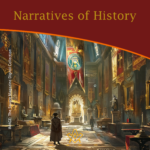 Narratives of History |
 A Very Royal Sesquicentenary |
 Unveiling the Enigma: Discover the Royal Society's Legacy and its Impact on Science. Delve into the fascinating history of the Royal Society, the prestigious UK academy shaping scientific progress since 1660. Explore its pivotal role in advancing knowledge, fostering collaboration, and unlocking the secrets of the universe. Prepare to be amazed! |
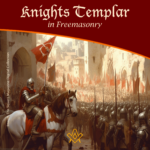 Knights Templar in Freemasonry Uncover the Mysteries of the Knights Templar in Freemasonry! Delve into the intriguing world where chivalry and symbolism intertwine. Discover the captivating rituals and ancient secrets behind the Knights Templar Masonic Orders. Explore the historical connection and delve into the enigmatic narratives that continue to fascinate enthusiasts today. Unveil the hidden truths now! |
 The Royal Arch stands as the rainbow of promise in the Ritual; it stands as the promise of the resurrection; of that which was lost and that it shall be recovered. The question arises as to whether the Master's Word was originally communicated in the Third Degree? On this point there is some diversity of opinion. Originally published in 1915, this insight into the Fourth Degree – the Holy Royal Arch – is as relevant today as it was over 100 years ago. |
 Unveiling the Mysteries of Druidism: Discover the Intriguing Connection with Freemasonry. Explore the ancient spiritual practice of Druidism and its fascinating ties to the enigmatic world of Freemasonry. Delve into the shared symbolism and rituals that have captivated minds for centuries. Unlock the secrets of these intertwined traditions today! |
 Uncover the legacy of freestone masons and their pivotal role in crafting medieval cathedrals. Discover the artistry behind their techniques, the hierarchy within their craft, and the enduring impact of their intricate carvings. A deep dive into the world of these master craftsmen awaits you! |
 Unearth the intriguing journey from Vincha Culture to Freemasonry. Discover how ancient building methods intertwine with modern Masonic philosophies. This exploration will shed light on the fascinating link between the Serbian term "shestarenye" and the symbolic significance of the compass in Freemasonry. |
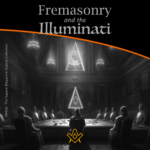 Freemasonry and the Illuminati Unravel the enigmatic world of Freemasonry and the Illuminati in our latest exposé. Dive into centuries-old mysteries, debunk conspiracy theories, and discover the truth behind these elusive societies. Are they puppet masters or mere myths? Join us as we dissect history and fact from fiction. |
 The Île des Templiers, or “Island of the Templars” lies within a leafy park in Paris. The execution site of Jacques du Molay, the last Grand Master of the Knights’ Templar bears a plaque with the epitaph ‘A cet endroit / Jacques de Molay / Dernier grand maître / de l'ordre du temple / a été brûlé le 18 Mars 1314’ (‘In this location / Jacques de Molay / Last grand master / of the order of the temple / was burned on 18 March 1314’) |
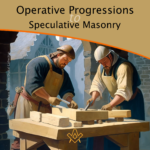 Operative Progressions to Speculative Masonry Both Operative and Speculative Masonry are an important part of the modern fraternity of Freemasonry, which combines elements of both traditions. Today, Freemasonry is a fraternity that is open to men of good character, who are interested in personal development and in making a positive contribution to their communities. |
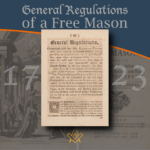 General Regulations of a Free Mason, 1723 General Regulations of a Free Mason as contained in Anderson's Constitutions of the Freemasons, published 1723. the Regulations are of great historical interest. Compiled by George Payne, the second Grand Master of the Premier Grand Lodge of England, they were printed in 1722/3, thus published just over five years after the formation of the Grand Lodge 1717. |
 The Genesis of the 1723 Book of Constitutions 2023, marks the three hundredth anniversary of the publication of the first printed Book of Constitutions of the Grand Lodge formally established in London two years previously. This is an anniversary whose significance extends beyond freemasonry. A paper by Andrew Prescott |
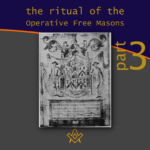 The Ritual of the Operative Free Masons - P3 Existing Operative Free Masons. The ritual I am about to refer, is that of "The Worshipful Society of Free Masons, Rough Masons, Wallers, Slaters, Paviors, Plaisterers, and Bricklayers." By Thomas Carr, M.D., P. M. Honorary Member of the Guild of Operative Free Masons |
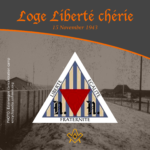 Liberté chérie was a Masonic Lodge founded in 1943 by Belgian Resistance fighters and other political prisoners at Esterwegen concentration camp. It was one of the few lodges of Freemasons founded within a Nazi concentration camp during the Second World War. |
 The Ritual of the Operative Free Masons - P2 If anyone doubts the fact that the formation of Speculative Free Masonry was due to and based upon Operative Free Masonry, it is quite easy to convince him of his error if he will only study the first Book of Constitutions. By Thomas Carr, M.D., P. M. Honorary Member of the Guild of Operative Free Masons |
 In 1881, Freemasonry rose from the ashes of a fire in the mining town of Kokomo, Summit County, Colorado. Corinthian Lodge No. 42, along with Kokomo, no longer exists but it holds the record of having been – at an elevation of 10,618 feet – the highest Masonic Lodge in the USA. |
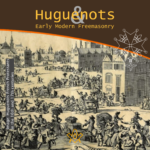 The Huguenots and Early Modern Freemasonry The Huguenots influence in the development of early modern Freemasonry at the time of the formation of the Grand Lodge in London around 1717 / 1723. |
 November is a month of reflection – perhaps due to the fact that we are getting close to the years' end – but also because Remembrance / Armistice Day (11 November) is a significant date in most countries' diaries. |
 Speculative Freemasonry, as practise by Grand Lodge of England, was officially born just over three hundred years ago, is today an international organisation, counting over six million members. It has been subjected to persecution, suppression, and abolition throughout its history. In its infancy, only a couple of decades after its official birth, it had already become a target. |
 The Ritual of the Operative Free Masons - P1 The original paper was written, first, to prove that Speculative Free Masonry was derived from Operative Free Masonry; second, to give some account of the Operative Free Masons, of their Ritual, and of their customs. By Thomas Carr, M.D., P. M. Honorary Member of the Guild of Operative Free Masons |
 American Fraternalism in the 19th and Early 20th Centuries The late 19th and early 20th centuries in the United States has been called the "Golden Age of Fraternalism." How did this come about and why was the idea of joining a fraternal organization so popular? We will explore this question and examine the regalia used by many fraternal organizations in this period. |
 Societas Draconistarum, meaning "Society of the Dragonists"– was a chivalric Order for selected nobility, founded in 1408 by Sigismund von Luxembourg, who through marriage became the King of Hungary (1387–1437) and later Holy Roman Emperor. The Order was fashioned after the military orders of the Crusades, requiring its initiates to defend the cross and fight the enemies of Christianity, in particular the Ottoman Empire. |
 The Perjured Free Mason Detected Was Samuel Prichard a perjured individual, or simply a misguided Freemason? Prichard's book "Free Masonry Dissected" published in 1730, is now used by many Masonic historians as a source of reference with regards to the introduction of the third degree into the Craft. But at the time it was published in 1730, it was not so well received by members of the Grand Lodge of England. |
 17th century and the Holy Royal Arch This article focuses on a period of transition between a point in time when we can safely and historically identify the first formation of what could be called as the ‘Royal Arch’ and the historical events that have preceded it. |
 Most Freemasons have heard the terms 'Operative' and 'Speculative' Masons, and this article helps to understand the difference: |
 Roberts' Constitutions of Freemasonry 1722 Published a year before Anderson's Constitutions, The Old Constitutions Belonging to the Ancient and Honourable SOCIETY OF Free and Accepted MASONS. Originally printed in London England; Sold by J. Roberts, in Warwick-Lane, MDCCXXII.(1722) |
 From 'Songs of religion and life', 1876 by John Stuart Blackie (1809-1895) |
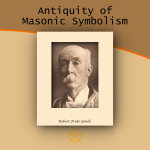 On the Antiquity of Masonic Symbolism Is the Symbolism of Masonry an inheritance derived from the old Masons who flourished before the era of the Grand Lodges (1717); or has it been borrowed from the Rosicrucians or others, after 1717? |
 Mason's Marks – from Egypt to Europe? Mason's marks have been a source of intrigue, not only to Freemasons but to historians and archaeologists. The use of simple pictograms have been employed for millennia by artisans to identify their work. But where did they originate and why? |
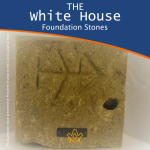 The White House Foundation Stones Further to the articles in our series on the history of the stone masons, we have a rather intriguing addition. During the 1950's renovation of the White House, President Truman retrieved more than 100 stone blocks with stonemasons marks. |
 What the Goose and Gridiron Tavern is in the ancient annals of London Freemasonry, The Green Dragon Tavern is to the memories of the Free-mason, of Boston and New England. |
 Auschwitz concentration camp: video photo article taken in 2013 |
 There are two things of importance happening this day - 27 January |
 Two approaches regarding the understanding of Freemasonry |
 Masonic Research in England c1930 An article which appeared in an American Masonic magazine, c1930 and which was reproduced in England, provoking a little controversy. |
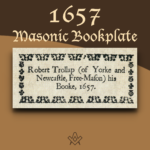 Masonic bookplates the ‘Brethren’s spiritual coats of arms and marks’ |
 The Unlawful Societies Act of 1799 Rebellious Freemasons and the 21st century |
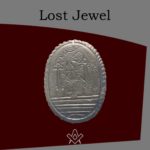 In 1912, Sarah Dowd of Dromore, Ireland, found a Masonic jewel dated 1517 - a date two hundred years before the establishment of Grand Lodge... |
 Freemasonry and Fascist Regime Interesting speech by the famous historian Prof. Aldo A. Mola, who links the fascist regime with the Masonic Associations. |
 Was famous Russian poet Alexander Pushkin a Freemason? And if so, was he a member of the lodge ‘for which all the lodges in Russia were destroyed’? |
 The Importance of Masonic Research Why is accurate - or authentic - Masonic research so important? The importance of making a daily advancement in Masonic knowledge is something that The Square is passionate about promoting. |
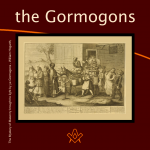 The Antient Noble Order of the Gormogons had a brief existence in the eighteenth century; they left few records or accomplishments, |
masonic knowledge
to be a better citizen of the world
share the square with two brothers

click image to open email app on mobile device


